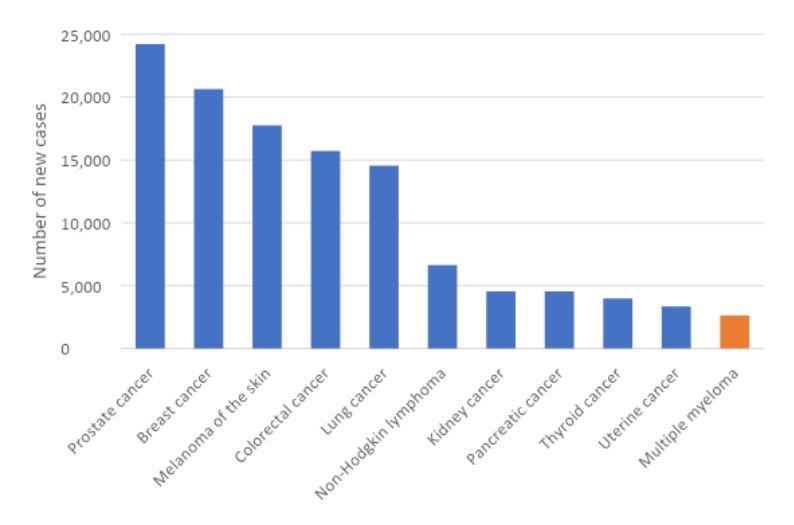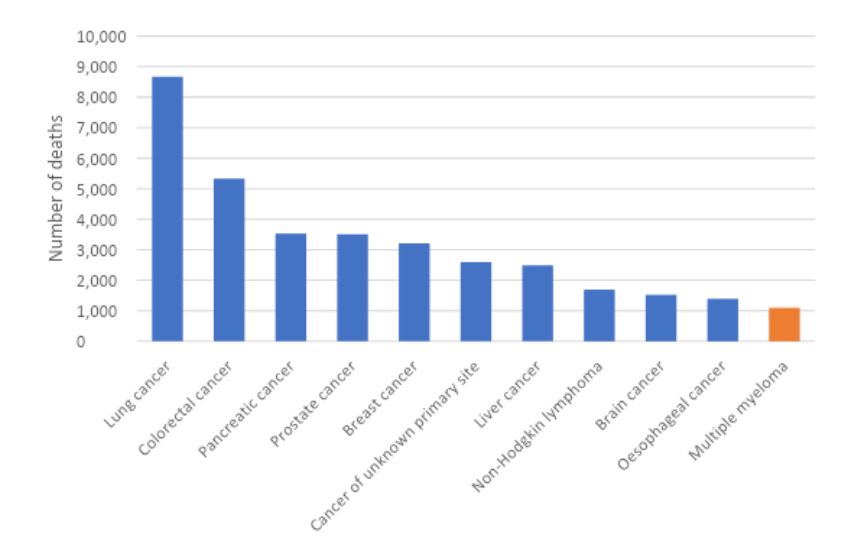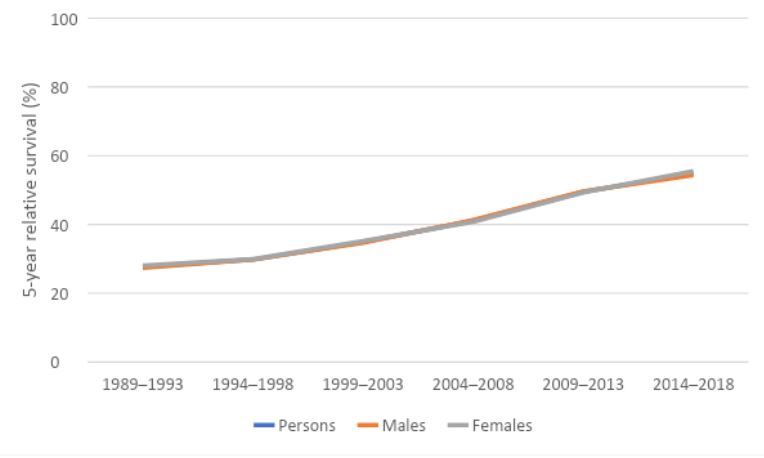The following material has been sourced from the Australian Institute of Health and Welfare
Multiple myeloma incorporates ICD-10 cancer codes C90.0 (Multiple myeloma).
Estimated number of new cases of multiple myeloma diagnosed in 2022
2,625 =  1,540 males +
1,540 males +  1,085 females
1,085 females
Estimated % of all new cancer cases diagnosed in 2022
1.6%
Estimated number of deaths from multiple myeloma in 2022
1,100 =  636 males +
636 males +  464 females
464 females
Estimated % of all deaths from cancer in 2022
2.2%
Chance of surviving at least 5 years (2014–2018)
55%
People living with multiple myeloma at the end of 2017 (diagnosed in the 5 year period 2013 to 2017)
6,511
New cases
In 2018, there were 2,247 new cases of multiple myeloma diagnosed in Australia (1,336 males and 910 females). In 2022, it is estimated that 2,625 new cases of multiple myeloma will be diagnosed in Australia (1,540 males and 1,085 females). In 2022, it is estimated that a person has a 1 in 111 (or 0.90%) risk of being diagnosed with multiple myeloma by the age of 85 (1 in 94 or 1.1% for males and 1 in 135 or 0.74% for females).

Figure 1. Estimated cancer incidence in Australia, 2022
Notes
- Data sourced from AIHW Cancer Data in Australia 2022 web report and supplementary data tables
- More information about incidence rates for the most common cancers diagnosed can be found on the NCCI website in the ‘Cancer incidence’ section (https://ncci.canceraustralia.gov.au/diagnosis/cancer-incidence/cancer-incidence)
In 2018, the age-standardised incidence rate was 7.6 cases per 100,000 persons (9.5 for males and 5.8 for females). In 2022, it is estimated that the age-standardised incidence rate will be 7.9 cases per 100,000 persons (9.8 for males and 6.2 for females). The incidence rate for multiple myeloma is expected to increase with age, highest for those aged 85–89 years.

Figure 2. Age-standardised incidence rates for multiple myeloma, 1982 to 2018, by sex
Notes:
- Data sourced from AIHW Cancer Data in Australia 2022 web report and supplementary data tables
- More information about incidence rates for multiple myeloma over time, by age, sex, Indigenous status, remoteness, and socioeconomic status (SES) can be found on the NCCI website in the ‘Cancer incidence’ section (https://ncci.canceraustralia.gov.au/diagnosis/cancer-incidence/cancer-incidence)
The number of new cases of multiple myeloma diagnosed increased from 566 (308 males and 258 females) in 1982 to 2,247 in 2018. Over the same period, the age-standardised incidence rate increased from 4.7 cases per 100,000 persons (5.9 for males and 3.8 for females) in 1982 to 7.6 cases per 100,000 in 2018.
Deaths
In 2020, there were 1,009 deaths from multiple myeloma in Australia (587 males and 422 females). In 2022, it is estimated that there will be 1,100 deaths (636 males and 464 females). In 2022, it is estimated that a person has a 1 in 289 (or 0.35%) risk of dying from multiple myeloma by the age of 85 (1 in 250 or 0.40% for males and 1 in 344 or 0.29% for females).

Figure 3. Estimated cancer mortality in Australia, 2022
Notes
- Data sourced from AIHW Cancer Data in Australia 2022 web report and supplementary data tables
- More information about mortality rates for the most common causes of cancer death can be found on the NCCI website in the ‘Cancer mortality’ section (https://ncci.canceraustralia.gov.au/outcomes/cancer-mortality/cancer-mortality)
In 2020, the age-standardised mortality rate was 3.1 deaths per 100,000 persons (3.9 for males and 2.3 for females). In 2022, it is estimated that the age-standardised mortality rate will be 3.1 deaths per 100,000 persons (4.0 for males and 2.5 for females). The mortality rate for multiple myeloma is expected to increase with age.

Figure 4. Age-standardised mortality rates for multiple myeloma, 1982 to 2020, by sex
Notes:
- Data sourced from AIHW Cancer Data in Australia 2022 web report and supplementary data tables
- More information about mortality rates for multiple myeloma over time, by age, sex, Indigenous status, remoteness, and socioeconomic status (SES) can be found on the NCCI website in the ‘Cancer mortality’ section (https://ncci.canceraustralia.gov.au/outcomes/cancer-mortality/cancer-mortality)
The number of deaths from multiple myeloma increased from 348 (182 males and 166 females) in 1982 to 1,009 in 2020. Over the same period, the age-standardised mortality rate remained similar from 3.0 deaths per 100,000 persons (3.8 for males and 2.5 for females) in 1982 to 3.1 deaths per 100,000 in 2020.
Survival
In 2014–2018, individuals diagnosed with multiple myeloma had a 55% chance (54% for males and 56% for females) of surviving for five years compared to their counterparts in the general Australian population. Between 1989–1993 and 2014–2018, five-year relative survival for multiple myeloma improved from 28% to 55%.

Figure 5. 5-year relative survival for multiple myeloma, 1989–1993 to 2014–2018, by sex
Notes:
- Data sourced from AIHW Cancer Data in Australia 2022 web report and supplementary data tables
- More information about 5-year relative survival rates for multiple myeloma over time, by age, sex, Indigenous status, remoteness, and socioeconomic status (SES) can be found on the NCCI website in the ‘Relative survival rate’ section (https://ncci.canceraustralia.gov.au/outcomes/relative-survival-rate/5-year-relative-survival-diagnosis)
Prevalence
At the end of 2017, there were 1,771 people living who had been diagnosed with multiple myeloma that year, 6,511 people living who had been diagnosed with multiple myeloma in the previous 5 years (from 2013 to 2017) and 10,479 people living who had been diagnosed with multiple myeloma in the previous 36 years (from 1982 to 2017).
For more information, see Multiple myeloma on the NCCI website
The National Cancer Control Indicators (NCCI) are a set of indicators across the continuum of cancer care, from Prevention and Screening through to Diagnosis, Treatment, Psychosocial care, Research and Outcomes. The NCCI website allows users to see visual representations of data on each indicator through interactive charts.




